Here Are The Top Browsers For Cross Browser Testing In 2020
Praveen Mishra
Posted On: October 26, 2020
![]() 175037 Views
175037 Views
![]() 12 Min Read
12 Min Read
We all know that user experience matters; it’s the key to delighting our customers. So, whether you are managing a live website or building a new one, you need to ensure a uniform user experience across all browsers and browser versions. Since web browsers don’t render the websites the same way, it becomes essential to perform cross browser testing and check website compatibility on different browsers.
By performing cross browser testing, you can ensure that the website behaves as intended across all the browsers. A website comprises the latest web technologies and languages such as HTML, CSS, Python, SQL, PHP, and JavaScript. All these web techs combine to give a complete look and function of the website. When these websites run on different web browsers, browsers execute the website code and display it to the users. But each browser interacts with websites uniquely and interprets the web components based on their arrangement to represent the website accordingly.
To ensure such uniformity across all the browsers can be tedious as you have to consider testing websites on different browsers and browser versions before making it live for the users. However, there is a better way of handling this while performing cross browser compatibility testing. The first step towards this should be to choose the most relevant browsers for testing. Now you must be wondering how to do that. Well, this blog will answer that. Let’s get to it, shall we?
TABLE OF CONTENT
How To Select Right Browsers For Compatibility Testing?
We all know that website is super important for every business these days. In fact, it is tough to find a successful business that doesn’t have a website. And we also know that first impression matters, and websites play an essential role in creating the first impression in your business. Therefore, it is crucial to perform browser compatibility testing to ensure that the website you designed for your brand works well in all types of browsers in different conditions.
The question arises, which are the most crucial web browsers you need to test your websites on. To answer this, you need to analyze the most critical browser and versions on the following basis:
- Basis of Popularity: Select the most commonly used browsers on popular platforms like Windows, Android, and iOS. In this way, you can increase the test coverage.
- Basis of Website Analysis: Analyze your website traffic through tools like Google Analytics and try to further breakdown based on browser, OS, and device. This will help you to understand which combination is most popular among your target audience.
Note: Any combination that has over 5% of traffic must be on your priority list.
Do you think you are testing your website on the right browsers? Well, to figure that, you need to take into consideration the geographical location of your visitors, devices they use, and the browser version they prefer. Now you must be wondering how to start or which browser you need to begin testing on. Well, you can start with the popular browsers. Given below are popular browsers in 2020 to articulate and modify your cross browser testing approach this year.
Let’s check the stats:
Familiarize Yourself With Browser Support Worldwide

- Chrome – 64.77%
- Safari – 17.61%
- Firefox – 4.31%
- Samsung Internet – 3.33%
- Opera – 1.96%
- UC Browser – 1.81%
As you can see from the image above, Google Chrome wins the market share among the browsers this year, with 64.77% of the user, making it the most popular browser just like the previous year. So, it is clear that you need to include Chrome in your testing strategy for sure. However, that does not mean that you can neglect other browsers like Safari that takes an overall 17.61% user base, making it the second most used browser.
Firefox is third with 4.31%, Samsung Internet fourth with 3.33%, Opera in fifth place with 1.96% users, and then UC Browser having 1.81% user base. Then comes the rest of the browsers like Microsoft Edge, Opera, Internet Explorer, etc. Though there are browsers that might not be popular globally, they can be critical to your business. For example, outdated browsers like IE and legacy edge need to be included in your browser list if your customers are using it.
It is significant to understand that technologies and business trends keep changing. One example of that change is Microsoft Edge moving to Chromium that will influence future web standards. Before Microsoft edge became Chromium, browser testers would skip the inbuilt testing browsers by Microsoft. After subsequent changes, it became smart to include the new Edge browser to keep up with the current web standards.
Considering browser versions is equally important while you are prioritizing the browser list. For example, considering Chrome as the most popular browser, you can include Chrome for Android and Chrome 80.0 in your priority list as they have the highest share among all versions of Chrome for Desktop and Android.
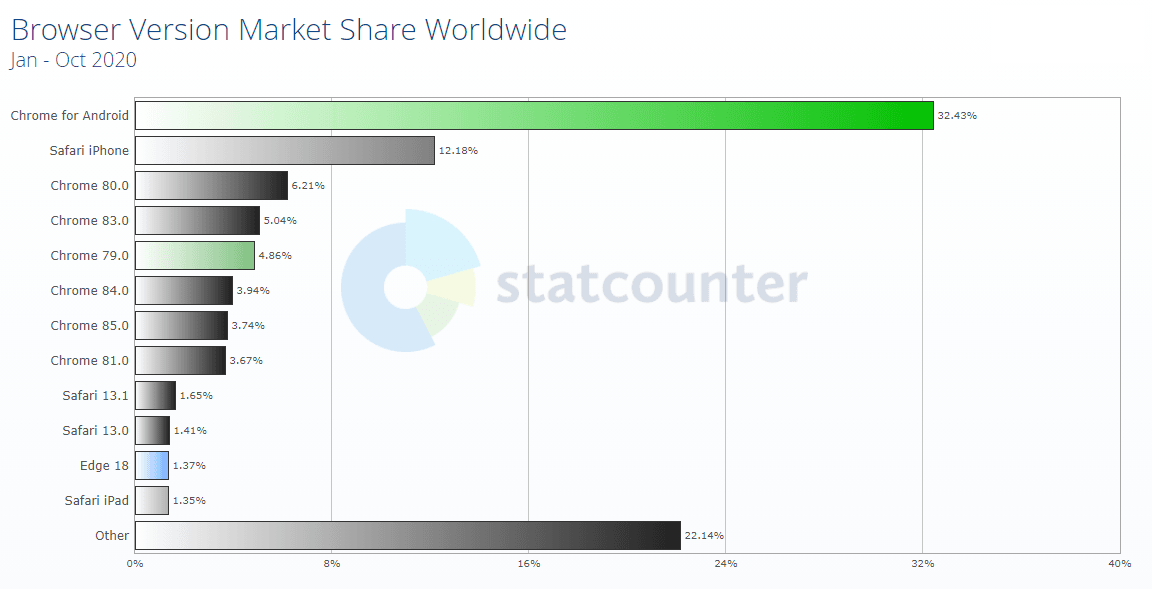
The above stats show the browser market share irrespective of the platforms being used. If you consider the platforms such as desktop, mobile, tablets, etc. the stats will change.
Know why cross browser testing is not only about browsers
Browser Popularity On Different Devices Worldwide
We have discussed before how browser compatibility is different on different devices. Now, let’s see the most popular browser based on the device being used.

We can see that Mobile is leading as the most used platform worldwide with 51.24% of market share as compared to Desktop and Tablet, which are 46.02% and 2.74%, respectively. Therefore, it is imperative to consider the popular browsers on mobile devices for cross browser testing.
Mobile
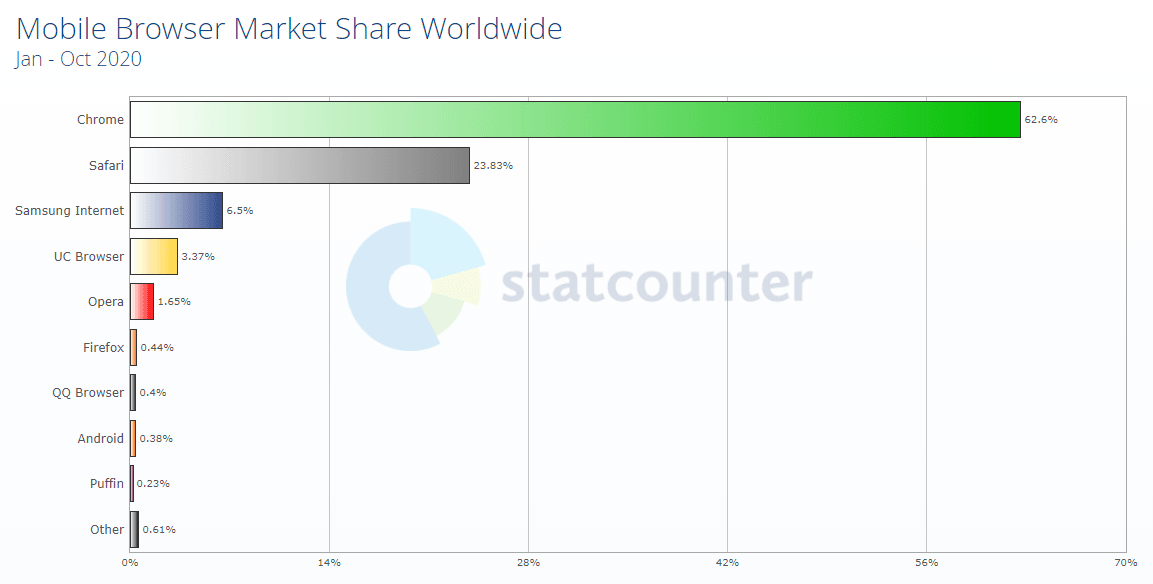
- Chrome – 62.6%
- Safari – 23.83%
- Samsung Internet – 6.5%
- UC Browser – 3.37%
- Opera – 1.65%
- Firefox – 0.44%
62.6% of users prefer Chrome for mobile browsing, making it the number one mobile browser. Safari browser ranks second with 23.83%, therefore including this browser is a must for targeting the mobile device audiences.
Next, we have Samsung Internet with a 6.5% score, and then comes the UC Browser and Opera with 3.37% and 1.65% users, respectively. You can consider including all these browsers while testing your website on mobile browsers.
Desktop

- Chrome – 69%
- Safari – 8.84%
- Firefox – 8.82%
- Edge Legacy – 3.26%
- IE – 3.06%
- Others – 7.02%
When it comes to desktop browsers, the first three positions go to Chrome, Safari, and Firefox, with almost 69%, 8.84%, and 8.82% market share. Edge and Internet Explorer take the fourth and fifth positions. Hence, it will be beneficial to keep these browsers in your plan for browser testing.
Tablets

- Safari – 49.33%
- Chrome – 36.4%
- Android – 11.96%
- Firefox – 0.69%
- Opera – 0.54%
- Others – 1.09%
Safari is the most used browser on tablets, with a market share of 49.33%. Chrome tends to lead the market for overall browser use but stands second on Table with a 36.4% user base. Hence, it is clear from this example why it is crucial to consider every device while performing browser testing.
Imagine you did not test the Safari browser enough, thinking that the Chrome browser is the most popular. In that case, you are neglecting the user-experience of all the Tablet users of your websites. If any of the features are not working fine in Safari, it will not work for all of the Tablet users, creating negative impacts on your business.
Browser Popularity In The Continental Regions On All Platforms
Do you know that user behavior and preference for choosing a browser change when we compare different geographies? Well, now, you do! Which makes it crucial to understand your users, especially if you target specific geography for your business.
United States Of America
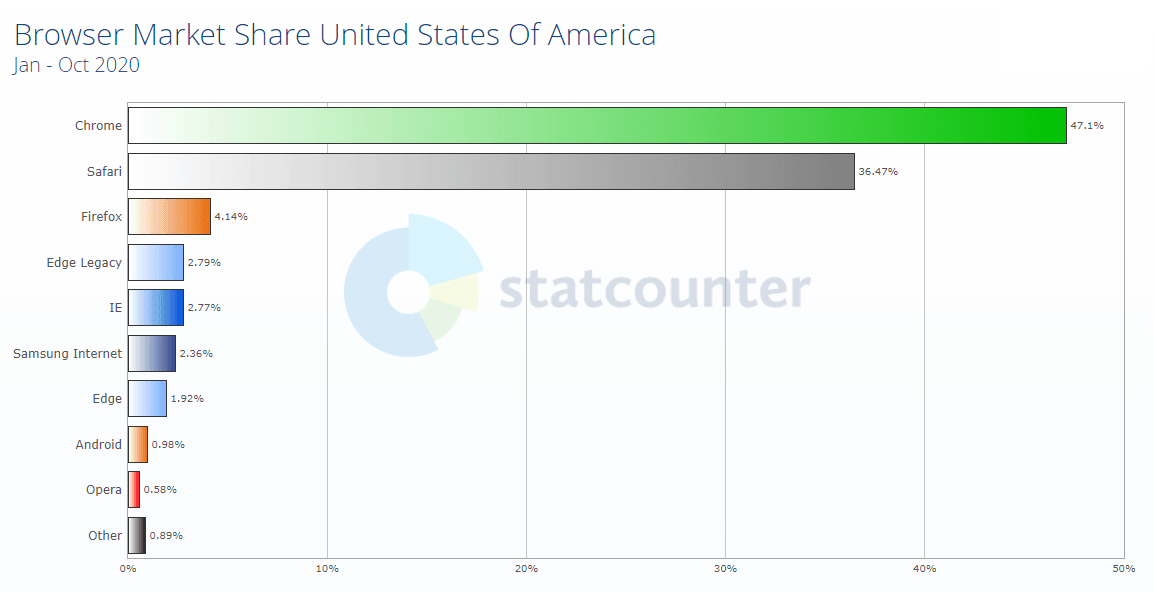
- Chrome – 47.1%
- Safari – 36.47%
- Firefox – 4.14%
- Edge Legacy – 2.79%
- IE – 2.77%
- Samsung Internet – 2.36%
Chrome and Safari are the two most essential browsers in the United States Of America, as we can see from the image above that 83.57% of users trust these two browsers. Taking a look at this chart can immensely help you to make the browser testing strategy here. We all should note that the user base here prefers legacy browsers like Edge and Internet Explorer too.
With Microsoft Edge becoming Chromium, it can bring an enormous change in this region’s stat. Compared to other continents, graphs are quite different here; therefore, select your browsers accordingly.
Note: Please keep in mind; these stats depict the overall popularity of the browser, including all the platforms in which users operate them, whether it is Mobile, Desktop, Tablet, etc. Therefore, you need to give priority to these browsers based on the running platforms as well.
Europe

- Chrome – 61.31%
- Safari – 18.33%
- Firefox – 7.14%
- Samsung Internet – 3.87%
- Opera – 2.28%
- Edge Legacy – 2.23%
Chrome is the most popular browser here; with a 61.31% share, it holds first place. Firefox is the second popular browser in Europe, although the difference here is that stats are relatively high compared to other regions with 18.33%.
There is not much change in the European market for the browser except that the Samsung Internet and Opera are now a little forward in share and other browsers like Yandex at the very end. Internet Explorer is quite behind in Europe, but as we know, the market keeps changing every day, and we can expect some changes here as well after Microsoft Edge became Chromium.
Asia

- Chrome – 71.09%
- Safari – 11.06%
- UC Browser – 4.04%
- Samsung Internet – 3.7%
- Firefox – 2.88%
- Opera – 1.82%
If you checked the stats last year, you could notice an immense difference between the UC Browser and Safari this year, which was much less last year, and UC Browser was popular than Safari. Therefore, you can strategize your testing process by giving Safari much more attention. Coming up next in popularity, we have Samsung Internet and Firefox with a small difference in numbers. Microsoft Edge and Internet Explorer are catching up here as well. Hence we have to watch out for these in Asia as well.
Africa
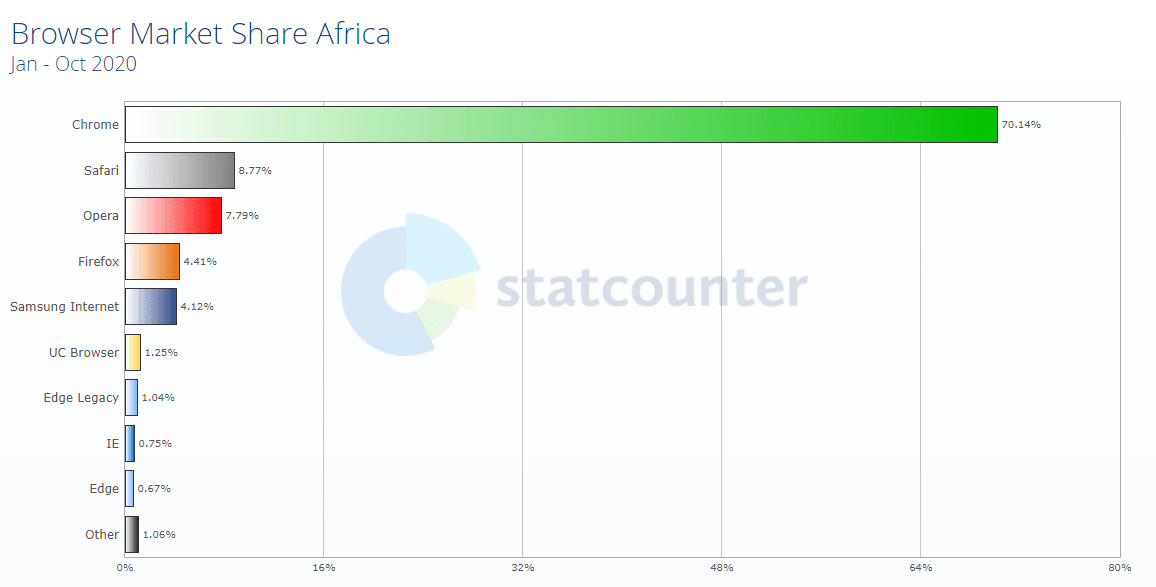
- Chrome – 70.14%
- Safari – 8.77%
- Opera – 7.79%
- Firefox – 4.41%
- Samsung Internet – 4.12%
- UC Browser – 1.25%
If we skip the all-time popular browser Chrome, we will see that Safari dominates the charts this year, leaving the Opera browser behind. Samsung Internet is now in fifth place, which was much behind last year. Surprisingly, Microsoft Edge and Internet Explorer are in the race after the UC Browser, which can be a great example of how going Chromium is beneficial for them. Although we still have to look forward to how new Edge is going to change the market trend in the coming days. For now, you can focus on these browsers for your target audience in Africa.
Oceania
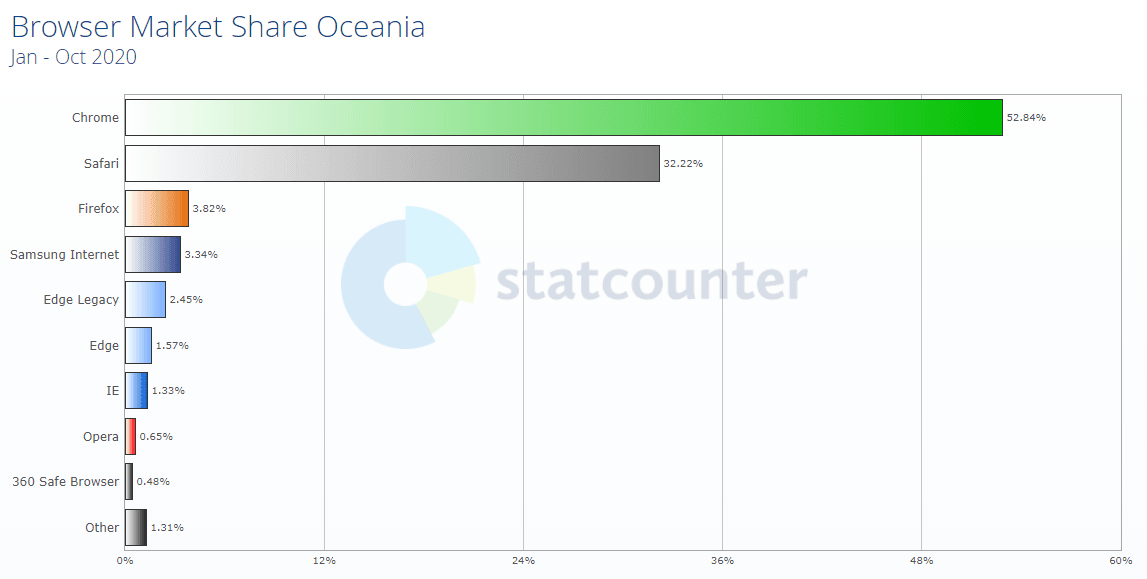
- Chrome – 52.84%
- Safari – 32.22%
- Firefox – 3.82%
- Samsung Internet – 3.34%
- Edge Legacy – 2.45%
- Edge – 1.57%
Catching up with North America’s graphs, the Oceania region also has a large user base, to be precise, 32.22% that uses Safari. Therefore, give priority to this browser for your targeted audience of this geographical area. You can keep Firefox and Samsung Internet as the third preference. Catching up with the competition, Edge Legacy and Edge come next with almost 2.45% and 1.57%, respectively.
From the above statistics of different continents, we can conclude that the user’s preferences vary. Some regions prefer Safari way too much, whereas some have quite similar stats for Safari and Firefox.
In certain areas, Internet Explorer and Edge come next, while Samsung Internet and Opera have a higher user base in other places. Therefore, you need to change and plan your browser testing strategy accordingly.
Find 5 excellent ways for mobile website testing.
LambdaTest’s LT Browser is a next-gen browser to build, test & debug mobile websites. Try it now, for free!
Wrapping Up
By now, you must be clear that Chrome is the most popular browser in all regions. That doesn’t mean you can overlook other popular browsers like Firefox and Safari. The second or the third most crucial browser based on different devices and geography are equally essential for targeting global audiences. Therefore, it becomes imperative to track the sources of your website traffic. When you have that data, you need to ensure that your website works seamlessly on those browsers and browser versions, including the older ones. Perform free end to end test on iPad simulator.
Installing so many browsers on different devices and testing them on those platforms can be very hectic. Therefore, proper planning is a must before browser testing. It would be best to strategize your cross browser testing by breaking down the browsers concerning device and geography. After knowing which browser is more prevalent in a specific device or country, you can test websites on different browsers based on your target audiences. However, to further ease down the cloud based browser testing effort, you can rely on tools like LambdaTest that provides feature like Geo Location Testing for better coverage along with automation testing, local testing, parallel testing, etc. Also, you can perform browser compatibility testing on popular browsers. For example, you can test on Chrome, test on Firefox, test on IE and furthermore.
Got Questions? Drop them on LambdaTest Community. Visit now













